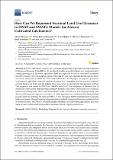| dc.description.abstract | In SWAT and SWAT+ models, the variations in hydrological processes are represented by Hydrological Response Units (HRUs). In the default models, agricultural land cover is represented by a single growing cycle. However, agricultural land use, especially in African cultivated catchments, typically consists of several cropping seasons, following dry and wet seasonal patterns, and are hence incorrectly represented in SWAT and SWAT+ default models. In this paper, we propose a procedure to incorporate agricultural seasonal land-use dynamics by (1) mapping land-use trajectories instead of static land-cover maps and (2) linking these trajectories to agricultural management settings. This approach was tested in SWAT and SWAT+ models of Usa catchment in Tanzania that is intensively cultivated by implementing dominant dynamic trajectories. Our results were evaluated with remote-sensing observations for Leaf Area Index (LAI), which showed that a single growing cycle did not well represent vegetation dynamics. A better agreement was obtained after implementing seasonal land-use dynamics for cultivated HRUs. It was concluded that the representation of seasonal land-use dynamics through trajectory implementation can lead to improved temporal patterns of LAI in default models. The SWAT+ model had higher flexibility in representing agricultural practices, using decision tables, and by being able to represent mixed cropping cultivations. | en_US |

